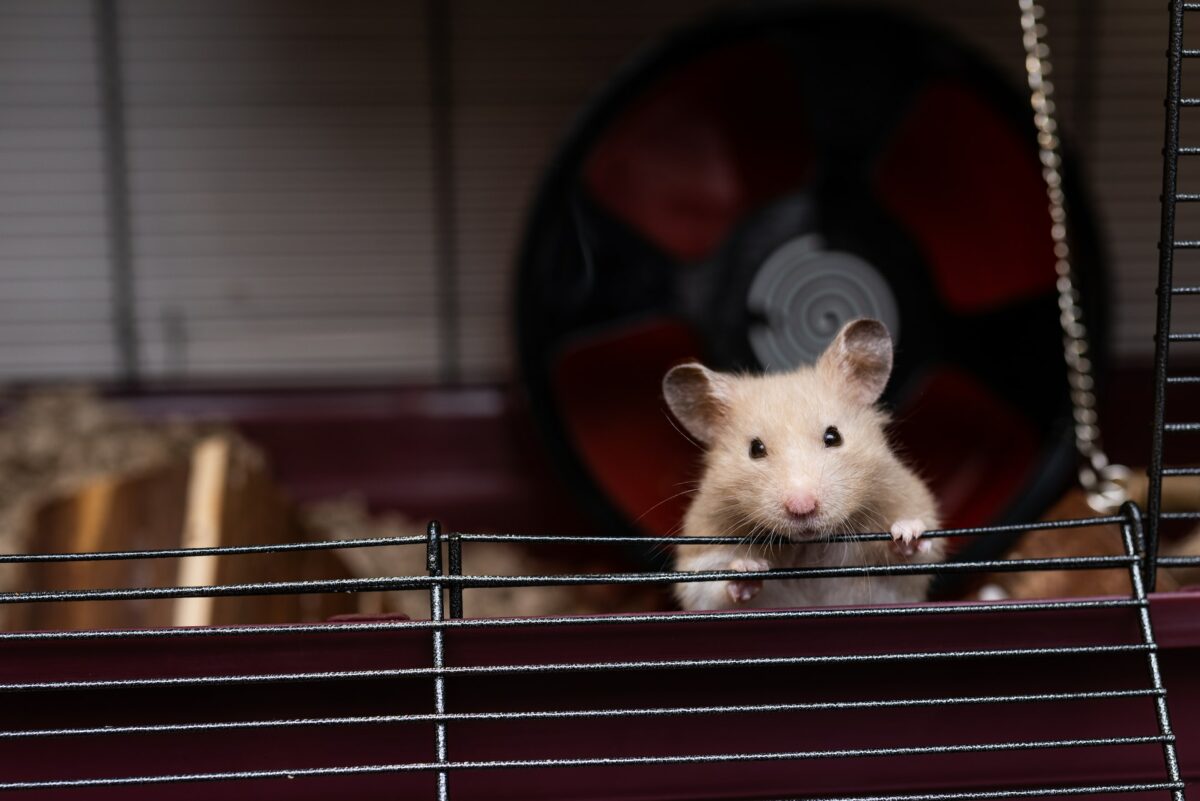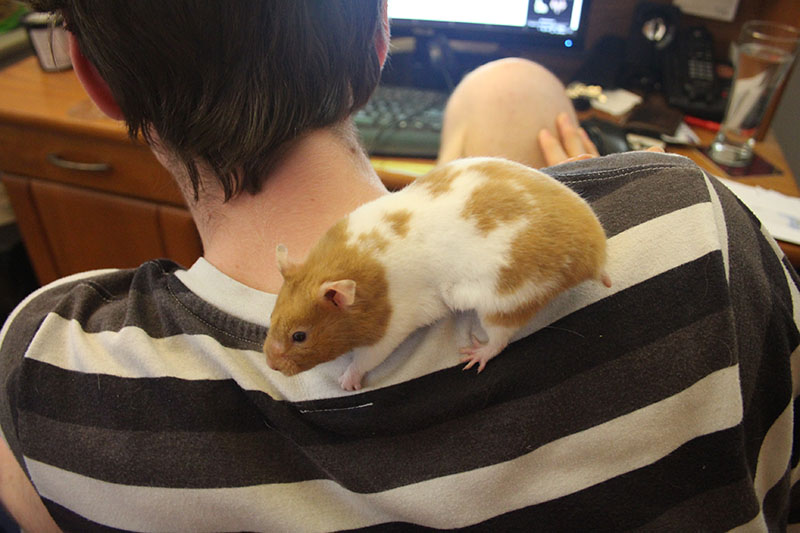As a pet owner, you may have noticed your little furry friend making sounds that seem to convey different meanings. Hamsters are no exception! These cute critters have a unique way of communicating that can be quite surprising for newbie pet owners. In this blog post, we will explore the common vocalization of hamsters in the English language, helping you understand what your furry friend might be trying to tell you. From squeaks to chirps, and even a growl or two, get ready to learn all about the meaningful sounds our little hamster friends can make!

1. Introduction: Hamsters are usually quiet, but they do make sounds! Here’s what they mean.
Hamsters are typically known for being quiet pets. However, they do make various sounds to communicate their emotions and needs. In this blog section, we will discuss the different vocalizations that hamsters make and what they mean. From the clicking sound of contentment to the high-pitched screams of fear, hamsters have a wide range of communication methods. It is essential for pet owners to understand these vocalizations to better care for their hamsters and interpret their behaviors. By listening to and observing your hamster’s sounds and body language, you can better understand their wants and needs. Overall, learning about the vocalizations of hamsters can help deepen your bond with these adorable and fascinating pets.

2. The clicking sound: When hamsters are happy, they make a clicking sound or bruxing.
Hamsters are known for being quiet pets, but they do make some interesting vocalizations! One of the most common sounds they make is a clicking noise, which is also known as bruxing. This sound occurs when hamsters are happy, content, or relaxed. It’s a soothing noise that can be compared to the sound of teeth grinding. If you hear your hamster making a clicking sound, it’s a great sign that they’re feeling comfortable and happy in their environment. Understanding your hamster’s vocalizations is an essential part of caring for them, and it can help you interpret their behaviors and emotions accurately. By paying attention to the clicking sound, you can develop a deeper bond with your pet and ensure that they’re living their best life.

3. Squeaking: The most common sound hamsters make is squeaking. It can signify fear, distress, or other emotions.
Hamsters might be small, but they can be vocal creatures. The most frequent sound hamsters make is squeaking. This sound can express various emotions, including fear, distress, or even excitement. As a pet owner, it’s essential to understand your hamster’s vocalizations. If you hear your hamster continually squeaking, it might indicate that they are uneasy or scared, and you should approach them gently. However, if you notice your hamster making a happy clicking sound or teeth grinding, it means they are content and relaxed. Remember that different types of hamsters can have different vocalization habits, but understanding their sounds can help you communicate with them better. Knowing your hamster well can help you become a better pet parent and give them a comfortable and thriving life.

4. Squealing: Hamsters can also make high-pitched squealing sounds. These can indicate pain, fear, or aggression.
In addition to squeaking, hamsters can also make high-pitched squealing sounds. These sounds can indicate a variety of emotions, including pain, fear, or aggression. It’s important to pay attention to your hamster’s other behaviors when they’re making this sound to determine the underlying cause. For example, if they’re huddled in a corner or appear skittish, they may be frightened. However, if they’re baring their teeth or exhibiting other aggressive behaviors, they may be feeling territorial or threatened. By understanding the different vocalizations of hamsters, pet owners can better care for their furry friends and create a safe and comfortable environment for them.

5. Screaming: While rare, it’s possible for hamsters to scream. This usually indicates extreme fear or pain.
While hamsters are generally quiet animals, they do have the ability to scream. This is a rare occurrence, but when it does happen, it’s usually a sign of extreme fear or pain. The sound is similar to a human scream, but with a closed mouth. As owners, it’s important to pay attention to our hamsters’ vocalizations to ensure their well-being. Along with screaming, hamsters also make clicking, squeaking, squealing, hissing, teeth grinding, and chirping sounds. Understanding these vocalizations can help us interpret their behaviors and provide better care for our furry friends. Communication is key in any relationship, even the ones we have with our pets.

6. Hissing: Some hamsters may hiss when they’re scared or angry. This is similar to a cat hissing.
Hamsters may seem like quiet creatures, but they do make sounds. One common vocalization is hissing, which can indicate that a hamster is scared or angry. This sound is similar to a cat hissing and may be used as a warning to potential threats. It’s important for pet owners to recognize when a hamster is hissing and to respond appropriately by giving them space or removing the source of their discomfort. Understanding the various vocalizations of hamsters can help owners better interpret their behaviors and provide proper care. From clicking when happy to screaming in extreme fear, each sound offers clues to a hamster’s emotional state. By paying attention to these sounds, owners can develop a stronger bond with their furry friends.

7. Teeth grinding: Hamsters may grind their teeth when they’re content or relaxed.
When hamsters are content or relaxed, they may grind their teeth, which can create a soft, rhythmic clicking sound also known as bruxing. This behavior is perfectly normal and nothing to worry about. In fact, it’s actually a sign of happiness and comfort. Similar to how humans may grind their teeth unconsciously when in a state of relaxation or pleasure, hamsters do the same. It’s a way for them to release tension and stimulate their teeth, which continue to grow throughout their lifespan. When caring for your hamster, it’s important to recognize and understand their vocalizations, including teeth grinding, as it can give you insight into their emotional state and overall health. By paying attention to your hamster’s behaviors and vocalizations, you can provide the best care possible and ensure their happiness and well-being.

8. Chirping: A high-pitched chirping sound can indicate apprehension, especially in new hamsters.
When it comes to the vocalizations of hamsters, chirping can indicate a range of emotions. A high-pitched chirping sound can often signify apprehension, especially in new hamsters. This is because these small pets can be easily spooked when they’re in unfamiliar surroundings. Therefore, if your hamster is making a chirping noise, it may be a sign that they’re feeling a little uneasy. However, if your hamster is in the company of another hammie, a chirping sound may indicate pure spirited playfulness. It’s important to pay close attention to the different sounds your hamster makes, as it can help you better understand their emotions and behaviors. By doing so, you can provide them with the best possible care and ensure they’re happy and healthy pets.

9. Vocal signaling in social interactions: Hamsters use vocalizations to communicate during mating and other social interactions.
When it comes to social interactions, hamsters are not always the quietest creatures. Vocalizations play a crucial role in their communication, particularly during mating and other social interactions. Male hamsters use vocal signals to attract a potential mate, using specific squeaks and clicking sounds as part of their seduction tactics. These vocalizations can also serve as a way of establishing dominance between male hamsters, and during playtime, hamsters may use a range of chirps, squeaks, and teeth grinding to communicate their contentment or anxiety. Understanding the different vocalizations hamsters make can help pet owners better interpret their behavior, and in turn, provide animals with the best care possible. By paying attention to these sounds, hamster owners can determine if their pet is happy, in distress, or in need of attention. Overall, vocal signaling serves as an essential aspect of hamster socialization, and it is crucial for pet owners to understand and respond to it accordingly.

10. Conclusion: Understanding the vocalizations of hamsters can help you better care for them and interpret their behaviors.
Understanding the vocalizations of hamsters is important in providing better care for them and interpreting their behaviors. Hamsters use different sounds to communicate and express their emotions, such as the clicking sound or bruxing when they are happy and the common squeaking sound when they feel fear or distress. It is also notable that hamsters can make high-pitched squealing sounds, indicating pain, fear, or aggression. In extreme situations, such as when hamsters feel intense fear or pain, they may scream. These behaviors can inform pet owners about the emotional and physical health of their hamsters, and they can learn how to make their hamsters feel safe and comfortable. Veterinary attention should be sought immediately in cases where hamsters show signs of pain, aggression, or other unusual behavior. Overall, understanding the vocalizations of hamsters can improve the bond between owners and their pets, leading to a happier, healthier relationship.
- Hamster Comparison: Which Breed Is The Perfect Fit For You? - April 15, 2024
- From Price To Value: Understanding The True Cost Of Owning A Hamster - April 15, 2024
- Harmony In Hamster Homes: Exploring Hamster Compatibility With Other Pets - April 15, 2024